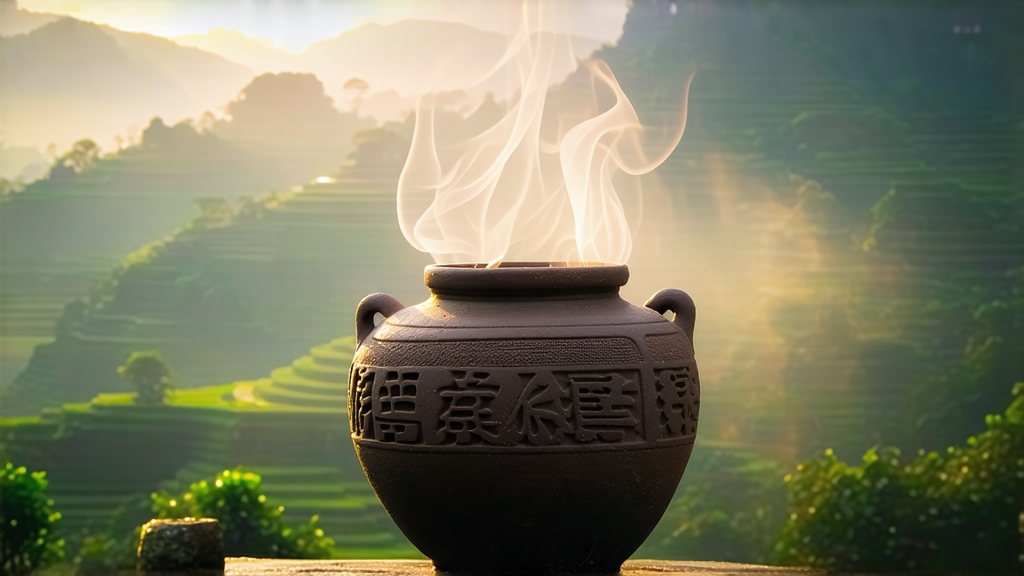
Tucked away in the subtropical mountains of southern China, Liu Bao tea is the quietest legend within the dark-tea family. While Pu-erh has become a global buzzword, Liu Bao remains the insider’s secret, a tea whose history is soaked in the sweat of porters, the creak of riverboats, and the scent of damp camphor wood. To understand Liu Bao is to listen to a 1,500-year-old conversation between microbes, merchants, and mountains.
Historical footprints
The earliest written record appears in the Liu Bao village chronicle of 1585, noting that “tea cakes were bartered for salt along the Xun River.” By the Qing dynasty the tea had become a strategic commodity. Compressed into 37-kilogram baskets, Liu Bao sailed down the Pearl River to Guangzhou, where foreign clipper ships carried it to Southeast Asia. Dockworkers in Singapore and Kuala Lumpur swore the tea cured dampness and malaria; tin-mine coolies drank it sweetened with condensed milk, calling it “kopi-tiam pu-erh” because the British mistakenly labeled every dark tea as Pu-erh. Thus Liu Bao slipped into diaspora history under an alias, aging quietly in the holds of ships and the attics of Peranakan shop houses.
Micro-terroirs within one county
Liu Bao is not a single recipe but a mosaic of micro-climates inside Wuzhou prefecture, Guangxi. The core is Liu Bao township itself, where red laterite soil forces the tea bushes to send roots deeper, concentrating polyphenols. Twenty kilometers north, the village of Tang Ping sits at 600 m; morning fog lowers temperature, slowing leaf growth and increasing the amino acid theanine, which later transmutes into cocoa-like sweetness. Eastward, the hamlet of He Ping harvests ten days earlier, yielding softer leaves favored for “light fermentation” lots aimed at Hong Kong dim-sum restaurants. Each slope keeps its own yeast strain on the bark of nearby cinnamon trees, so a blind tasting can reveal whether a Liu Bao originated from the shady side of Lion Mountain or the limestone ridge of Nine Dragons.
Crafting the darkness
The journey from fresh leaf to mellow liquor is a choreography of heat, humidity, and human judgment. Picking begins at dawn when two leaves and a bud still hold night dew; the dew acts as a natural inoculum for later fermentation. After a brief outdoor withering, leaves are plunged into 280 °C woks for shaqing (kill-green) lasting exactly 240 seconds—longer would lock in bitterness, shorter would leave grassy notes. While still warm, the leaf is piled 70 cm deep inside bamboo-lined troughs. A tea master known as the “wet-pile conductor” sprays calculated amounts of Xun River water, its mineral hardness 180 ppm, ideal for nurturing Eurotium cristatum, the golden “flower” spore that will later freckle the finished bricks. The pile is covered with hemp sacks and left to breathe; internal temperature is checked every hour with a cypress stick. When the thermometer hits 55 °C the pile is forked over, a process repeated seven times over 25 days. After piling, the leaf is steamed, pressed into gunny-lined bamboo baskets, and transferred to underground cellars whose walls weep with condensation year-round. Here the tea will rest for a minimum of three years, often twenty. The baskets are stacked cross-wise so air can snake upward, carrying with it microbes from older vintages—an invisible vertical solera system.
Decoding the flavor spiral
A well-aged Liu Bao offers aromas that puzzle newcomers: damp driftwood, star anise, and something reminiscent of betel nut without the bite. The cup is ox-blood red under light, almost black in shadow. First infusions taste of jujube and river stone; by the fifth, dark chocolate and camphor emerge. The throat feel—what Cantonese call ganyun—is a cooling mentholated breath that arrives thirty seconds after swallowing, as if the tea were a mint lozenge in reverse. The Chinese describe this as “returning sweetness along the canal of the neck.” Professional cuppers look for a lingering petrichor note that signals successful Eurotium bloom; its absence suggests the tea was rushed through electric dryers rather than cellar-aged.
Rituals of brewing
Unlike Pu-erh, Liu Bao forgives heavy hands. Its tannins have been tamed by years of microbial wrestling, so boiling water is welcome. Gongfu aficionados use a